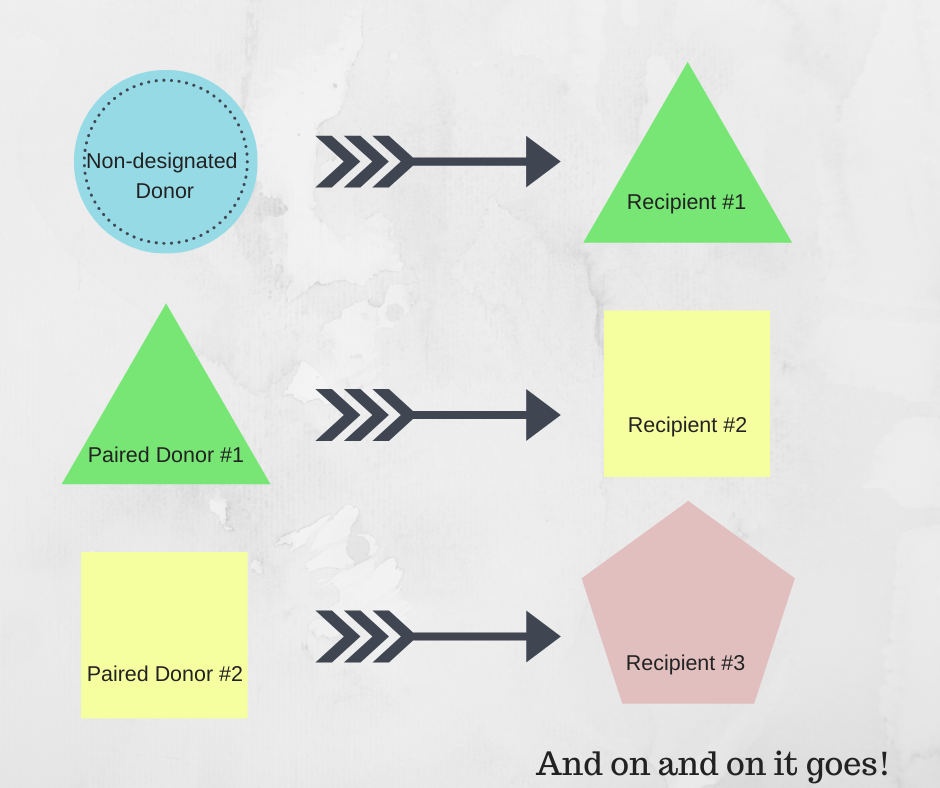Living donation is a unique and profound way to help someone in need. Maybe a news story or a friend's social media post sparked an interest in living donation. Maybe you have always thought donating an organ would be an amazing thing to do (it is!). Or perhaps you have a family member on dialysis and are inspired to help. Regardless of how you have come to the idea of living donation, you likely want more information about the donation process and we are here to help.
Types of Living Donation
News outlets are full of living donor stories celebrating people who were "a perfect match". Really, almost no one is an absolute "perfect" match and successful transplants happen all the time with matches that are not 100%--some between people with different blood types! In fact, living donation comes in many types of experiences including:
Directed Donation
In a directed donation, the donor is intent on giving to one particular person and the donor kidney goes from the living donor to the intended recipient.
Non-Directed Donation
In a non-directed donation, the donor decides to give without any intended recipient. This type of donation can connect with incompatible donor/recipient pairs to create chains of living donors and recipients, often helping more than just the original recipient. You may see this called "Good Samaritan" or "altruistic" donation, but really, all living donors are altruistic!
Paired Donation
In paired donation, a living donor is not a biological match for their intended recipient, but is willing to give a kidney to someone else so the intended recipient can receive a kidney from another living donor. These can be swaps between two pairs or, if a non-directed donor is available, they can end in longer chains of donors and recipients. Not all transplant centers offer paired donation, but if you are approved to be a donor, but are not a match for your specific person, this is a terrific way to help them and others, too!

How Does Living Donation Happen?
Living donation is a process that can take several months or sometimes up to a year. Every effort is made by a transplant center to make sure living donation does not pose a threat to a potential donor, and this takes time. While each person's experience is unique, the basic components of the living donation journey are:
- Contact with a transplant center or donation organization
- Initial screening questionnaire
- Health and mental health screenings
- Matching with a recipient (non-designated and paired kidney exchange)
- Scheduling surgery
- Surgery
- Recovery
- Follow up visits for two years
What is the Donation Surgery Like?
Living donor surgery (nephrectomy) and transplant surgery are changing rapidly, so you should ask specific questions of your living donor coordinator about technique and what your surgeon prefers. Here are some common types of surgery:
Laparoscopic
In a laproscopic nephrectomy, the kidney is released from the body using small laproscopic instruments and removed through a slightly larger incision in the belly. This type of surgery is minimally invasive and often involves 4-6 small incisions and one larger incision under the bikini line.
Single-incision Belly-button
This newer surgery involves going through the belly button laparoscopically to remove the kidney. Since the incision is in the belly button, there are no other scars involved.
In either case, donors typically check into the hospital, prep for surgery (same day or next day), experience a 3-4 hour surgery and are released from the hospital in 2-3 days. As with everything, each donor is different, so this is a general statement and your experience could vary from this.
How Long is Recovery?
Each donor is different, but in general, it can take donors 6-8 weeks to get back to their normal routines if there are no other complications. Some donors go back to work in 2 weeks and some go back in 2 months. Additionally, many living donors feel fatigue for 6-8 months following surgery, but again, each donor's recovery is unique.
Can I Live a Normal Life After Donation?
Yes! While a very small number of donors experience complications following surgery, the majority of living donors go back to their normal lives after recovery, including working, dancing, running, lifting weights and traveling. You can eat and drink your favorite foods and beverages without restrictions. You should avoid nuclear medicine when possible and NSAIDs (found in over the counter pain relievers), but otherwise you should be back to normal. You should discuss any risks, possible complications and lifetime health outcomes with your living donor coordinator.
Can I Talk to Someone Who Has Been a Living Donor?
Yes! We have volunteers serving as mentors for people interested in living donation. These men and women are located around the state and have been through the full living donation experience. Contact our office at info@donatelifenc.org for more information.